

According to WHO’s Global Health Estimate’s previous data about causes of worldwide death and disability [1], the report suggested the first cause of mortality is heart disease, and the probability of heart disease menacing human life is still on the increase. Coronary artery disease (CAD), which is well known as ischemic heart disease [2], is the top 1 disease that could lead to 80% of cases of sudden cardiac death (SCD) globally. It’s the most common type of heart disease, resulting in approximately 27 624 daily deaths in the world [3]. Sudden cardiac arrest is the most time-critical and challenging medical emergency, which can strike without warning when the heart stops beating and cannot pump blood to the brain, lungs, and other organs. In order to restore normal heart rhythm, a procedure called defibrillation is done through an automated external defibrillator (AED).
What is an Automated External Defibrillator?
In order to reduce the sudden cardiac death (SCD) risk and enhance the chance of survival, we need an effective solution to buy time for the dying person before the ambulance arrives, so Automated External Defibrillator has been invented.
An automated External Defibrillator (AED) is a portable medical device used to analyze the heart rhythm of a patient in sudden cardiac arrest and instruct the user to deliver an electric shock through the chest wall to the heart to return the patient’s heartbeat to normal.
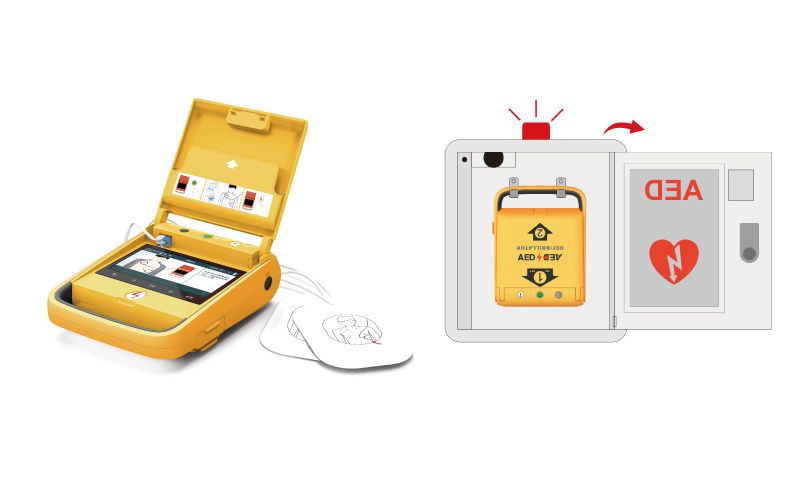
The AED is the best defibrillator applied for emergency access to a non-breathing child aged 8 or older who weighs more than 55 pounds, or an adult, especially in the case of bystander intervention of a witnessed cardiac arrest [4]. Because of the AED’s practicability and easy use, it’s installed in public places such as airports, offices, train stations, transport, gym, sports-related facilities, etc. We could easily find AED in a red or white steel box with a glass window and a heart-shaped logo [5].
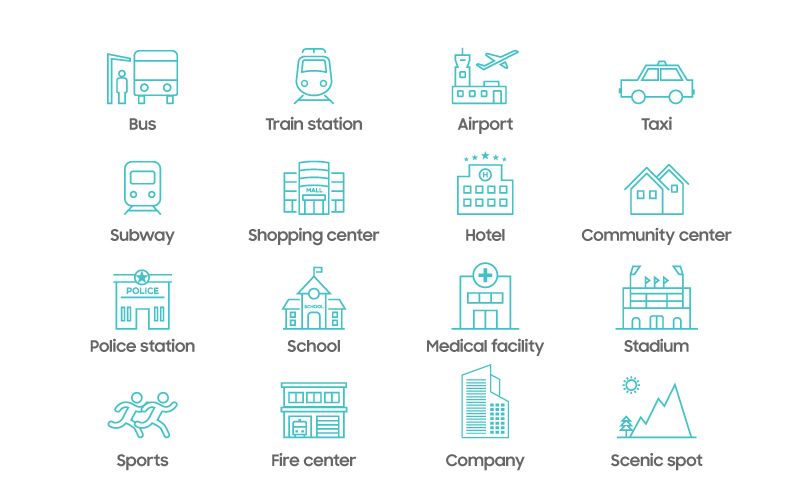
Why is AED so important in our life?
As we know, sudden cardiac arrest (SCA) can happen to anyone regardless of age, gender, or size on any occasion. Therefore, the rescue of out-of-hospital cardiac arrest is very important to protect the life safety of the public and maintain the health of the whole people. The principal cause of cardiac arrest is ventricular fibrillation or ventricular tachycardia. Defibrillation is used for ventricular fibrillation and pulseless ventricular tachycardia.
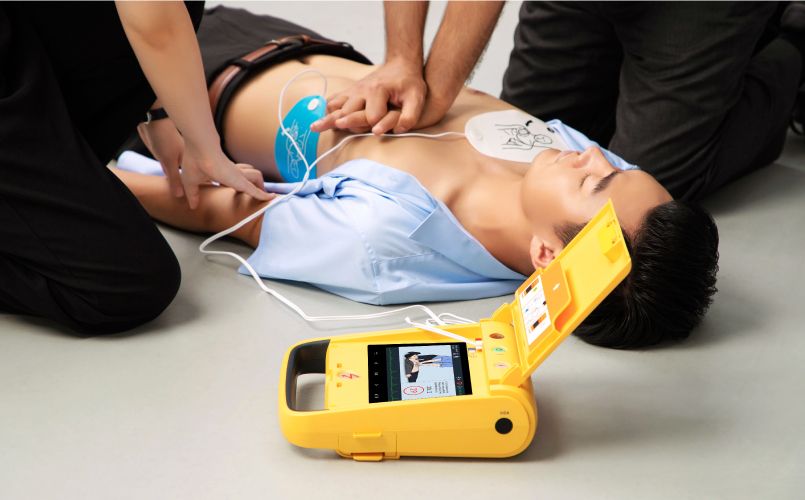
At present, there are three main types of defibrillators available: automated external defibrillator (AED), implantable cardioverter-defibrillator (ICD), and wearable cardioverter defibrillator (WCD) [6].
The only effective treatment for sudden cardiac arrest (SCA) patients in public places is an electric shock that could be released by an automated external defibrillator (AED). AED has the significant purpose of first aid in public locations, which plays a crucial part in the survival chain approved by the American Heart Association (AHA). The American heart association (AHA) reported in 2018 that 89.4% of sudden cardiac death (SCD) occurred outside the hospital. If the patients can't be given emergency treatment in time when they suffer a sudden cardiac arrest, their chance of survival decreases by 7% to 10% for each minute [7], which may cause the most terrible result like permanent brain damage or persistent vegetable state.
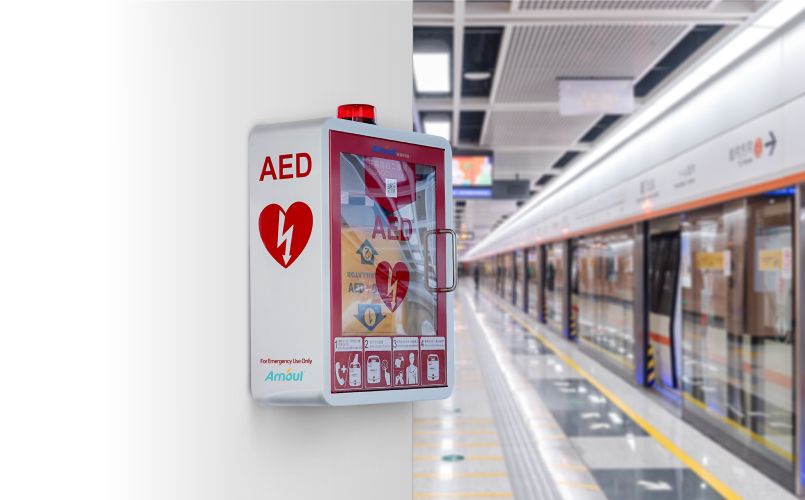
How AEDs save people's lives?
The AED is called a public lifesaver. So it’s purposely designed as a simple and portable device that could be operated by non-medical professionals trained in first aid. Innovative portable AEDs enable more people to respond to an emergency situation. They strengthen the chain of survival with rapid defibrillation by first responders using automated external defibrillators to restore a normal heart rhythm in victims of cardiac arrest.
An AED system comprises an AED device and accessories, such as a battery, pad electrodes, and sometimes an adapter. Generally, most AED devices provide visual and audible instructions to guide users to finish the rescue effortlessly by themselves.
How to operate an AED
1. Power on the AED
Press just an "on" button to launch the procedure of AED, then follow the voice prompts or visual instructions.
2. Attach the AED electrode pads
Take off the victim's upper wear covering the chest, and wipe the chest dry if necessary. And then attach the self-adhesive monitor-defibrillator electrode pads directly to the victim's skin. Place one electrode pad on the upper right side of the chest, another one on the lower left side of the chest, a few inches below the left armpit.
Note: If the pads may touch, place one pad in the middle of the chest and the other pad on the back, between the shoulder blades.
3. Analyze the heart rhythm
Before starting to analyze the heart rhythm, evacuation of a crowd is a primary thing to avoid all movement affecting the patient during rhythm analysis leading to a wrong diagnosis.
Some AED devices don't have the automatic analysis function, so we need to press an "analyze" button to proceed with this operation. Other AED devices could analyze automatically when the electrode pads are attached to the chest. The whole heart rhythm analysis takes 5-15 seconds normally. Specifically, it depends on the AED product. If an AED device detects ventricular fibrillation (VF), it will announce through a displayed message, visual or auditory alarm, or voice-synthesized statement that a shock is indicated.
4. Press the shock button
If the "shock" button is advised, press it. Once the shock is delivered, or if no shock is demanded necessary, you will be prompted to check if the person has normal breathing or circulation. If not, you will be reminded to perform 2 minutes (about 5 cycles) of CPR. And continue to follow the AED's prompts until further treatment can be provided [5][8].
AED product recommendations
Amoul® AED i3 & i5 are impressive devices used for children and adults as emergency life-saving solutions. They can detect the abnormal situation of the heartbeat and then provides the biphasic truncated exponential waveform defibrillation, which is more effective and has less risk of injury to the heart than monophasic waveforms. It increases the survival chances of patients to bring their life back in good time. They provide both visual and voice instructions to tell you exactly what you should do through the resuscitation process. During an intense rescue, AED i3&i5's regular self-test feature enables the improvement of the successful operation rate furthest.
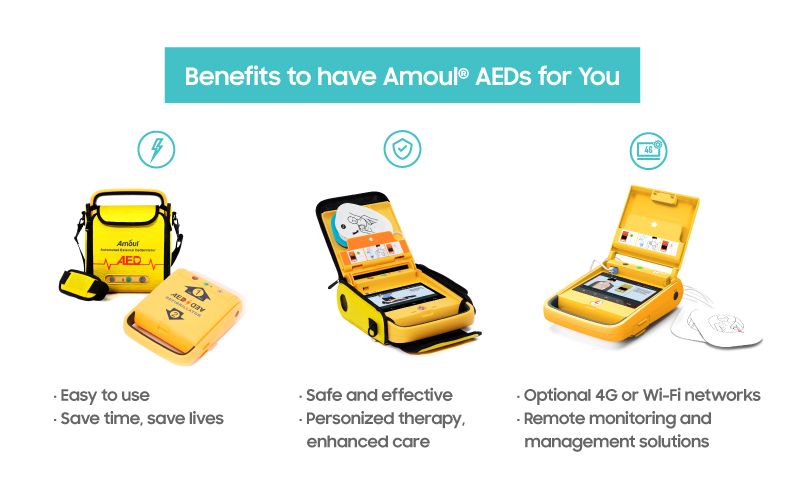
They are both light enough to be carried easily and receive an IP54 rating for waterproof and dust-free. High energy and long-life lithium manganese dioxide battery ensure 4-5 years stand-by life and a minimum of 200 shocks or four hours of continuous use.
Additionally, the Defibrillator Management Platform feature is a safe and effective way to administer automated external defibrillators remotely. Through the platform, you can track the detailed information of all defibrillators registered in the system and check the status of each unit, which simplifies the rescue process and helps the institution better manage the patients' needs.
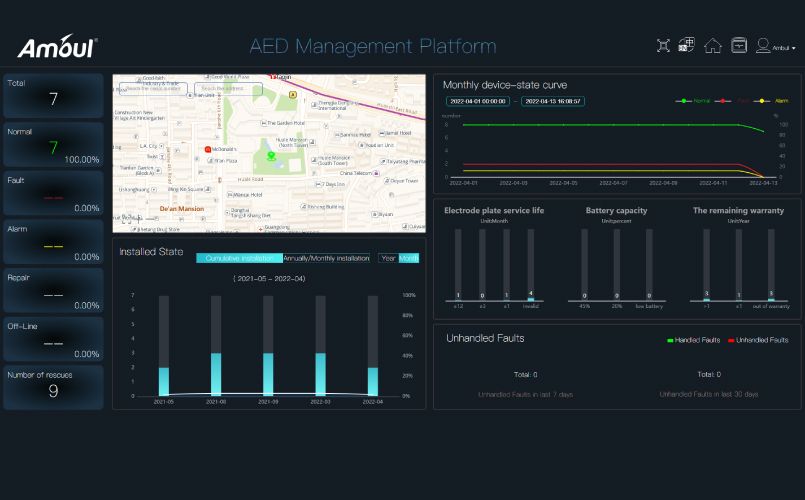
Conclusion:
The popularization of AED is a cost-effective solution to save millions of people from sudden cardiac death, so there is no doubt about the importance of installing an AED in every single public and private building. Thanks to the innovation of new technologies, the AED devices are always developed to improve their functions and features to better respond to modern’s demands. With simple AED training, the rescuer could execute the operation with ease and enable to respond safely to a medical emergency that requires defibrillation.
References:
1. Global Health Estimates: Life expectancy and leading causes of death and disability. World Health Organization. Available at:
https://www.who.int/data/gho/data/themes/mortality-and-global-health-estimates
2. World death statistics in 2021. Deadorkicking. Available at:
https://deadorkicking.com/death-statistics/worldwide/2021/
3. Deathmeters 2022. Deathmeters. Available at:
https://deathmeters.info/
4. Comprehensive medical assisting exam review. Third version. P346. Preparation for the CMA, RMA, and CMAS Exams. J.P.Cody. 2011.
5. AED steps. American Red Cross. Available at:
https://www.redcross.org/take-a-class/aed/using-an-aed/aed-steps
6. The role of AEDs in reducing risks of SCD. Joyce H.Lee, MS. Medical College of Wisconsin, Class of 2024. Available at:
https://sudc.org/the-role-of-aeds-in-reducing-risks-of-sudden-cardiac-death/
7. Improving AED awareness and access to save lives! The University of PENNSYLVANIA. Available at:
https://www.med.upenn.edu/myheartmap/aed.html
8. How AED in public places can restart hearts? FDA. 02/09/2021
Available at:
https://www.fda.gov/consumers/consumer-updates/how-aeds-public-places-can-restart-hearts